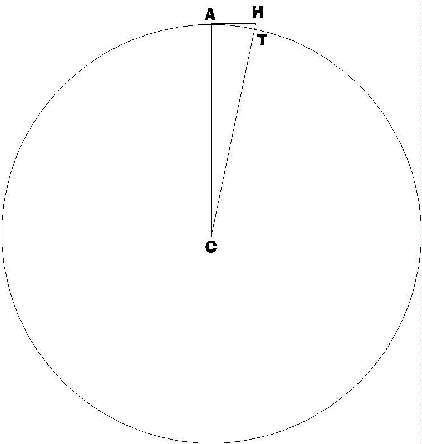Return to homework index
Physics 109N Homework #3
Due Tuesday September 24, 1996
Out of sight?
 1. If you stand on a beach,
and the ocean is fairly peaceful, the distance you can see-the
horizon-relates to the curvature of the earth. H and T denote
your head and toes as you stand on the beach. A is the furthest
you can see the surface of the water. C is the center of the earth.
AH is a tangent to the earth's surface at A (right?), so CAH is
a right angled triangle. Apply Pythagoras' theorem to this triangle,
and see if you can figure out how far away the horizon is-that
is, assume HT is one-thousandth of a mile (is it?) take the earth's
diameter to be 7,900 miles, and figure out just how far
you can see, before the earth's curvature stops you.
1. If you stand on a beach,
and the ocean is fairly peaceful, the distance you can see-the
horizon-relates to the curvature of the earth. H and T denote
your head and toes as you stand on the beach. A is the furthest
you can see the surface of the water. C is the center of the earth.
AH is a tangent to the earth's surface at A (right?), so CAH is
a right angled triangle. Apply Pythagoras' theorem to this triangle,
and see if you can figure out how far away the horizon is-that
is, assume HT is one-thousandth of a mile (is it?) take the earth's
diameter to be 7,900 miles, and figure out just how far
you can see, before the earth's curvature stops you.
Equinox
2. On Monday, September 23, the sun will set exactly twelve hours
after it rises in Charlottesville. For what other parts of the
world will that also be true? Where in the world will the sun
be exactly overhead at midday on Monday? Describe the motion
of the sun as seen in the sky from the north pole on that
day. What is the angle between the vertical and a pencil pointing
directly at the sun at midday in Charlottesville on Saturday?
What is the latitude of Charlottesville? Are these angles
related?
Wise guys
3. After reviewing the notes, and any other material you wish,
decide who you think are the twelve Greek scientist/mathematicians
who contributed most to our understanding of the universe (not
counting medical or theological contributions). Construct a "time-line",
by which I mean plot out on a piece of paper, with a scale from
600 BC to 200 AD, say, showing each one's lifetime with a line.
Put the person's name by each line, and a few words about what
they did.
Easy as pi
4. Check your understanding of Archimedes' calculation of pi by finding what
lower bound on the value of pi you can discover by inscribing first a
square, then a regular octagon, in a circle.
 1. If you stand on a beach,
and the ocean is fairly peaceful, the distance you can see-the
horizon-relates to the curvature of the earth. H and T denote
your head and toes as you stand on the beach. A is the furthest
you can see the surface of the water. C is the center of the earth.
AH is a tangent to the earth's surface at A (right?), so CAH is
a right angled triangle. Apply Pythagoras' theorem to this triangle,
and see if you can figure out how far away the horizon is-that
is, assume HT is one-thousandth of a mile (is it?) take the earth's
diameter to be 7,900 miles, and figure out just how far
you can see, before the earth's curvature stops you.
1. If you stand on a beach,
and the ocean is fairly peaceful, the distance you can see-the
horizon-relates to the curvature of the earth. H and T denote
your head and toes as you stand on the beach. A is the furthest
you can see the surface of the water. C is the center of the earth.
AH is a tangent to the earth's surface at A (right?), so CAH is
a right angled triangle. Apply Pythagoras' theorem to this triangle,
and see if you can figure out how far away the horizon is-that
is, assume HT is one-thousandth of a mile (is it?) take the earth's
diameter to be 7,900 miles, and figure out just how far
you can see, before the earth's curvature stops you.